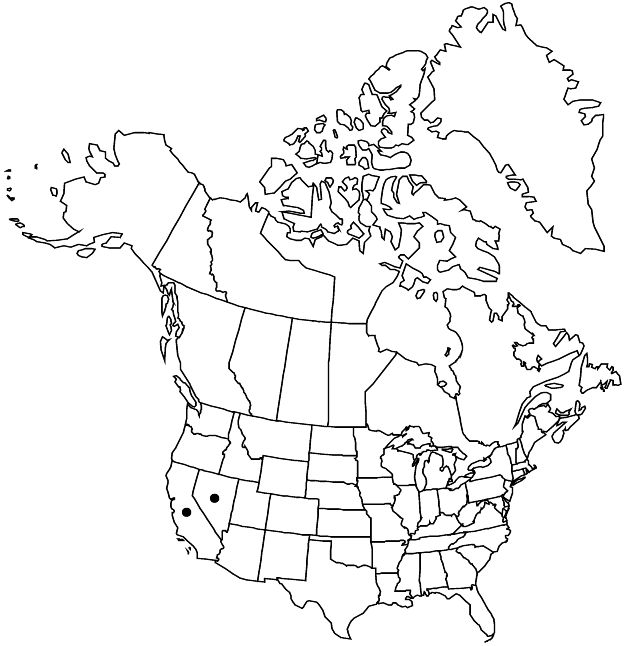Difference between revisions of "Eriogonum incanum"
Proc. Amer. Acad. Arts 8: 161. 1870.
FNA>Volume Importer |
imported>Volume Importer |
||
| (4 intermediate revisions by one other user not shown) | |||
| Line 8: | Line 8: | ||
}} | }} | ||
|common_names=Frosted wild buckwheat | |common_names=Frosted wild buckwheat | ||
| + | |special_status={{Treatment/ID/Special_status | ||
| + | |code=E | ||
| + | |label=Endemic | ||
| + | }} | ||
|basionyms= | |basionyms= | ||
|synonyms={{Treatment/ID/Synonym | |synonyms={{Treatment/ID/Synonym | ||
|name=Eriogonum marifolium var. incanum | |name=Eriogonum marifolium var. incanum | ||
|authority=(Torrey & A. Gray) M. E. Jones | |authority=(Torrey & A. Gray) M. E. Jones | ||
| + | |rank=variety | ||
}} {{Treatment/ID/Synonym | }} {{Treatment/ID/Synonym | ||
|name=Eriogonum ursinum var. rosulatum | |name=Eriogonum ursinum var. rosulatum | ||
|authority=(Small) S. Stokes | |authority=(Small) S. Stokes | ||
| + | |rank=variety | ||
}} | }} | ||
|hierarchy=Polygonaceae;Polygonaceae subfam. Eriogonoideae;Eriogonum;Eriogonum subg. Oligogonum;Eriogonum incanum | |hierarchy=Polygonaceae;Polygonaceae subfam. Eriogonoideae;Eriogonum;Eriogonum subg. Oligogonum;Eriogonum incanum | ||
| Line 39: | Line 45: | ||
-->{{#Taxon: | -->{{#Taxon: | ||
name=Eriogonum incanum | name=Eriogonum incanum | ||
| − | |||
|authority=Torrey & A. Gray | |authority=Torrey & A. Gray | ||
|rank=species | |rank=species | ||
| Line 53: | Line 58: | ||
|publication title=Proc. Amer. Acad. Arts | |publication title=Proc. Amer. Acad. Arts | ||
|publication year=1870 | |publication year=1870 | ||
| − | |special status= | + | |special status=Endemic |
| − | |source xml=https:// | + | |source xml=https://bitbucket.org/aafc-mbb/fna-data-curation/src/2e0870ddd59836b60bcf96646a41e87ea5a5943a/coarse_grained_fna_xml/V5/V5_751.xml |
|subfamily=Polygonaceae subfam. Eriogonoideae | |subfamily=Polygonaceae subfam. Eriogonoideae | ||
|genus=Eriogonum | |genus=Eriogonum | ||
Latest revision as of 22:13, 5 November 2020
Herbs, matted, dioecious, 0.5–3 × 1–4 dm wide, tomentose to floccose. Stems: caudex spreading; aerial flowering stems erect or nearly so, slender, solid, not fistulose, arising at nodes of caudex branches and at distal nodes of short, nonflowering aerial branches, 0.1–2(–2.5) dm, tomentose to floccose. Leaves in loose to congested basal rosettes; petiole (0.3–)0.5–1 cm, tomentose; blade oblong to oblong-ovate or spatulate, 0.5–1.5 × 0.3–0.7 cm, densely white- or grayish-tomentose on both surfaces, sometimes greenish adaxially, margins entire, plane. Inflorescences capitate and 0.5–2 cm wide, mature pistillate plants open and umbellate, 1–3 × 1–4 cm; branches tomentose to floccose; bracts 2–6, leaflike, 0.1–0.5 × 0.1–0.3 cm, often absent immediately below involucre. Involucres 1 per node but occasionally appearing congested, turbinate-campanulate, 2.5–3 × 2–2.5 mm, tomentose; teeth 5–8, erect, 0.5–1 mm. Flowers stipelike base 0.5–1 mm; perianth yellow, glabrous; staminate flowers 2–3 mm, tepals ovate; pistillate flowers 4–6 mm, tepals oblanceolate, often becoming reddish in fruit; stamens exserted, 2–3 mm; filaments pilose proximally. Achenes light brown to brown, 3–3.5 mm, glabrous except for sparsely pubescent beak.
Phenology: Flowering Jun–Sep.
Habitat: Sandy to gravelly or rocky granitic or occasionally volcanic flats, slopes, and outcrops, mixed grassland, manzanita, and sagebrush communities, montane conifer woodlands
Elevation: (1900-) 2100-4000 m
Discussion
Eriogonum incanum is common throughout the central and southern Sierra Nevada of California (Alpine, El Dorado, Fresno, Inyo, Madera, Mariposa, Nevada, Tulare, and Tuolumne counties) and extreme west-central Nevada (Carson City, Douglas, and Washoe counties). It is a food plant for the green hairstreak butterfly (Callophrys lemberti), the Pacific dotted-blue (Euphilotes enoptes), and the gorgon copper (Gaeides gorgon).
Selected References
None.
